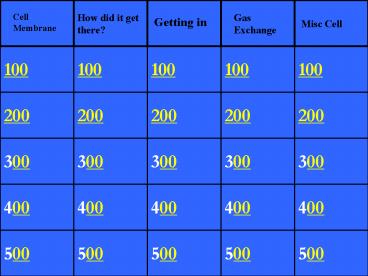Cell Membrane - PowerPoint PPT Presentation
1 / 51
Title:
Cell Membrane
Description:
The structures of the cell membranethat act as antennae to receive chemical messages ... cavity, trachea, pharynx, larynx, bronchus, bronchioles, alveoli, capillaries, ... – PowerPoint PPT presentation
Number of Views:20
Avg rating:3.0/5.0
Title: Cell Membrane
1
Cell Membrane
How did it get there?
Gas Exchange
Getting in
Misc Cell
100
100
100
100
100
200
200
200
200
200
300
300
300
300
300
400
400
400
400
400
500
500
500
500
500
2
Number of layers of the cell membrane
3
Two
4
What are the layers of the cell membrane made of?
5
Phosolipids and Proteins
6
The structures of the cell membranethat act as
antennae to receive chemical messages
7
Glycoproteins and glycolipids
8
The nonpolar tails of phospholipids tend to repel
? and let ? Molecules pass through.
9
Ions and fat soluble
10
Explain the structures of this diagram
11
(No Transcript)
12
Water moving from a high to low concentration
through a selectively permeable membrane.
13
osmosis
14
What is diffusion?
15
Movement of molecules from a high to low
concentration.
16
What happens to the molecules when a cell reaches
equilibrium?
17
Concentrations are equal, but movement still
occurs.
18
What is facilitated diffusion?
19
Diffusion (high to low concentrations) through
protein channels to allow large molecules through.
20
Two ways that facilitated diffusion and active
transport are different.
21
Low to high concentration, active requires energy.
22
What are channels made of?
23
protein
24
What would happen if a cell was impermeable?
25
die
26
An animal cell surrounded by fresh water the
turgor pressure can increase to the point the the
cell will..
27
burst
28
If a cell s internal salt concentration is 5
What would happen to the cell if it was placed in
water with .02 salt solution
29
Water will diffusion into the cell.
30
If a cell were treated with a chemical that
inhibits active transport what would happen to
the cell?
31
Cell would die
32
Which has a high O2 Concentration water or air
33
air
34
The primary concern of land gas exchange is..
35
Drying out of the surfaces
36
The structure in the lungs of mammals that
exchanges gases with the capillaries____
37
aveoli
38
The total surface area of all the alveoli in the
average persons lungs?
- 2 meters
- 12 meters
- 60 meters
- 600 meters
39
60 meters
40
Describe the path that air takes through the body.
41
Nose, nasal cavity, trachea, pharynx, larynx,
bronchus, bronchioles, alveoli, capillaries,
blood through the body back to lungs and out.
42
How do gases get in and out of plant cells?
43
Stomates, surrounded by guard cells open and
close to allow gases in and out.
44
Function of oils and waxes on human skin
45
Prevent water loss
46
Plant water loss
47
Transpiration
48
What are three functions of the nephrons?
49
Filtration, secretion and reabsorption
50
Three types of nitrogen wastes secreted by
animals.
51
Ammonia-directly into water-fike fishUrea-
diluted in water-MammalsUric Acid-non-soluble,no
n toxic Birds and desert reptiles































